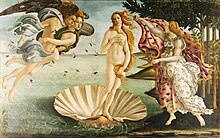This is an old revision of this page, as edited by Idoghor Melody (talk | contribs) at 10:56, 13 January 2025 (clean up, added orphan, uncategorised tags, typo(s) fixed: ’s → 's (2)). The present address (URL) is a permanent link to this revision, which may differ significantly from the current revision.
Revision as of 10:56, 13 January 2025 by Idoghor Melody (talk | contribs) (clean up, added orphan, uncategorised tags, typo(s) fixed: ’s → 's (2))(diff) ← Previous revision | Latest revision (diff) | Newer revision → (diff)This article has multiple issues. Please help improve it or discuss these issues on the talk page. (Learn how and when to remove these messages)
|
Sea foam art is an art genre that focuses on capturing the ephemeral beauty of sea foam. It symbolizes the transient nature of life and the dynamic interplay between land and sea, themes that have been explored across various cultures and artistic movements.
Historical depictions

Ancient Greek Influence
In ancient Greek mythology, sea foam is famously associated with the birth of Aphrodite, the goddess of love, who is said to have emerged from the sea's froth. This imagery has inspired numerous works, most notably Sandro Botticelli's painting The Birth of Venus (c. 1484–1486)., which depicts Venus standing on a shell, propelled toward the shore by the wind gods, with sea foam symbolizing her divine origin.
Japanese art
Japanese art has long celebrated natural elements, including the sea and its movements. Artists such as Ogata Kōrin have depicted the dynamic essence of ocean waves and foam. His work "Rough Waves," exemplifies the cultural reverence for nature's beauty and power, as well as themes of impermanence and the transient nature of existence, aligning with the Japanese aesthetic principle of "mono no aware."
Impressionist interpretations
The Impressionist movement brought a renewed focus on natural light and movement. Artists such as Joaquín Sorolla y Bastida explored the interplay of light and water. His painting Boy in Sea Foam captures a child wading through foamy waters, employing a vibrant palette to illustrate the dynamic interaction of light and movement.
Contemporary expressions
In modern times, artists continue to explore sea foam as a subject, employing various mediums and techniques. For instance, self-taught artist Harsh Chhajed has developed a unique style centered on sea foam art, dedicating himself to this craft since 1974.
Artistic techniques
Depicting sea foam presents unique challenges due to its intricate patterns and transient nature. Artists employ various techniques to capture its essence, such as using contrasting brushstrokes, layering, and glazing to convey the texture and movement of foam within seascapes. Acrylic painting tutorials, for example, guide artists in capturing the texture and movement of sea foam in seascapes.
Notable works

- The Birth of Venus by Sandro Botticelli: This iconic painting depicts the goddess Venus emerging from the sea on a shell, with sea foam symbolizing her divine origin.
- Rough Waves by Ogata Kōrin: A Japanese artwork capturing the dynamic and powerful movement of ocean waves and foam.
- Boy in Sea Foam by Joaquín Sorolla: An Impressionist painting portraying a child wading through foamy waters, highlighting the interplay of light and movement.
See also
- Sea foam: A type of foam created by the agitation of seawater
- Marine art: A genre of art that portrays or draws inspiration from the sea
- Seascape: Artistic representations of the sea.
- List of art techniques: A compilation of various methods used in creating art
References
- "Boy in Sea Foam, 1900 - Joaquín Sorolla - WikiArt.org". www.wikiart.org. Retrieved 2025-01-13.
- "Sea Foam Art: A Fusion of Nature and Creativity". Memeraki Retail and Tech Pvt Ltd. 2024-10-29. Retrieved 2025-01-13.
| This article has not been added to any content categories. Please help out by adding categories to it so that it can be listed with similar articles. (January 2025) |